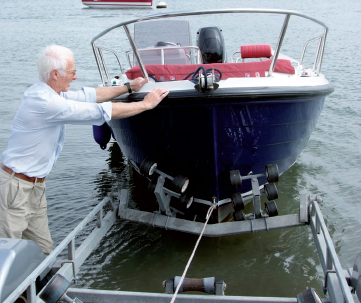Transporting and launching trailable powerboats
Sports fishing boats like the Orkney are designed to be dry sailed: stored ashore on their trailers during the week so that they don’t attract weed or require antifouling, and launched and recovered on their trailer each time they are used. Many marinas now have a secure pen to store the boats and some operate dry stack storage using forklift trucks to store, launch and recover them on demand. But if you have the space to store the boat on its trailer at home, then it is often simpler and certainly cheaper to launch and recover the boat yourself.
Towing regulations in many countries stipulate that the dry weight of the towing vehicle must, at a minimum, equal the weight of the trailer, which should also have brakes. Some countries also restrict the driving age to those over 21 who must also pass an additional test, so do check that your driving licence allows you to tow a heavy trailer and your vehicle is compatible before setting out on the road.
The Orkney weighs 3,240lb (1,470kg) and with her outboard engine raised, draws only 12in (30cm) of water so can be towed behind any mid-range family car.
Regulations vary between countries, so check with the tourist authorities of the states you intend to drive through to ensure that your boat and trailer complies with local laws. As crew, many countries now require that the skipper holds a valid VHF certificate and International Certificate of Competence (ICC) or higher qualification. It is best to check with the national boating authority in each country, and carry the certificates with you.
The difference between a safe, simple launch and a dangerous or stressful one is down to planning and preparation.
Check out your intended launch site ahead of time by calling the harbour master, river authority or marina office. Will there be enough water? Are there facilities to park the car and trailer? How steep is the slipway? Front and rear wheel drive vehicles will struggle on steep inclines especially if the surface is slippery. Some public slipways are free, but many are not. Local bylaws sometimes restrict the type of boat that can be launched and a permit may be required.
What time is high water? This may dictate launch and recovery times.
Standard requirements
The vehicle
- Car and trailer insurance documents with international travel endorsements
- Registration documents
- Warning triangle and set of spare bulbs.
The boat
- Original VAT sales receipt
- Insurance certificate with international travel endorsements
- Purchase flares at your destination. Flares are banned on most ferries, and some countries require a firearms certificate.
Checklist for launching
- Remove side straps, covers and lighting board
- Keep winch strap attached to bow
- Insert bungs, and close drainage flaps and inspection hatches
- Allow 30 minutes for wheel bearings to cool down before immersion
- Check engine oil and fuel levels.

1 Ensure the trailer is loaded slightly front heavy to avoid it ‘snaking’ out of control when braking. Plug in trailer lights and check that they are all working. Loop the safety wire around the ball hitch and lock the jockey wheel in place.

2 Tie the boat down on its trailer using adjustable webbing straps or a lorry driver’s hitch. Check that outboard/outdrives are locked in the raised position, and fit a day-glow warning/protective bag over the propellers.

3 Modern multi-roller trailers make launching and recovery of even quite large boats easy for one person to do, without the need to immerse the trailer.

4 The multi-rollers at the back of the trailer pivot and swivel automatically to take the same attitude as the boat as it rolls off into the water.

5 Take care not to immerse the brakes and hubs, especially in sea water. If there is no alternative, then allow 30 minutes for them to cool down before immersion and rinse with fresh water straight after.

6 Control the boat as it slides down the trailer by lacing the painter around the trailer handles and keep the winch wire attached to the boat. If the boat does run away, keep well clear of the winch handle.

7 Keep a wary eye open for passing vessels kicking up a wash. This can affect the smooth operation of launching, so wait for the water to flatten before starting.

8 Once afloat, lead the boat away from the trailer to avoid waves banging the hull up against it. Recover the trailer and park above the high-water mark.

1 Trim the engine/sterndrive up to stop it from grounding, and drive the boat onto the trailer.

2 Attach the winch line to the bow and tension it to keep the boat pressed against the rollers.

3 Line the boat up with the centre of the trailer and take account of wind and stream.

4 Winch the boat up onto the trailer.

5 Check that the boat remains central on the trailer and that the supporting rollers do not capsize.

6 Once on the trailer, check that the rollers are firmly against the hull and adjust if necessary.

7 Flush the engine cooling system with fresh water to rinse out the salt water within the cooling system.

8 Wash down the boat and trailer. The latest trailers are fitted with hose connection points to flush the brakes.
